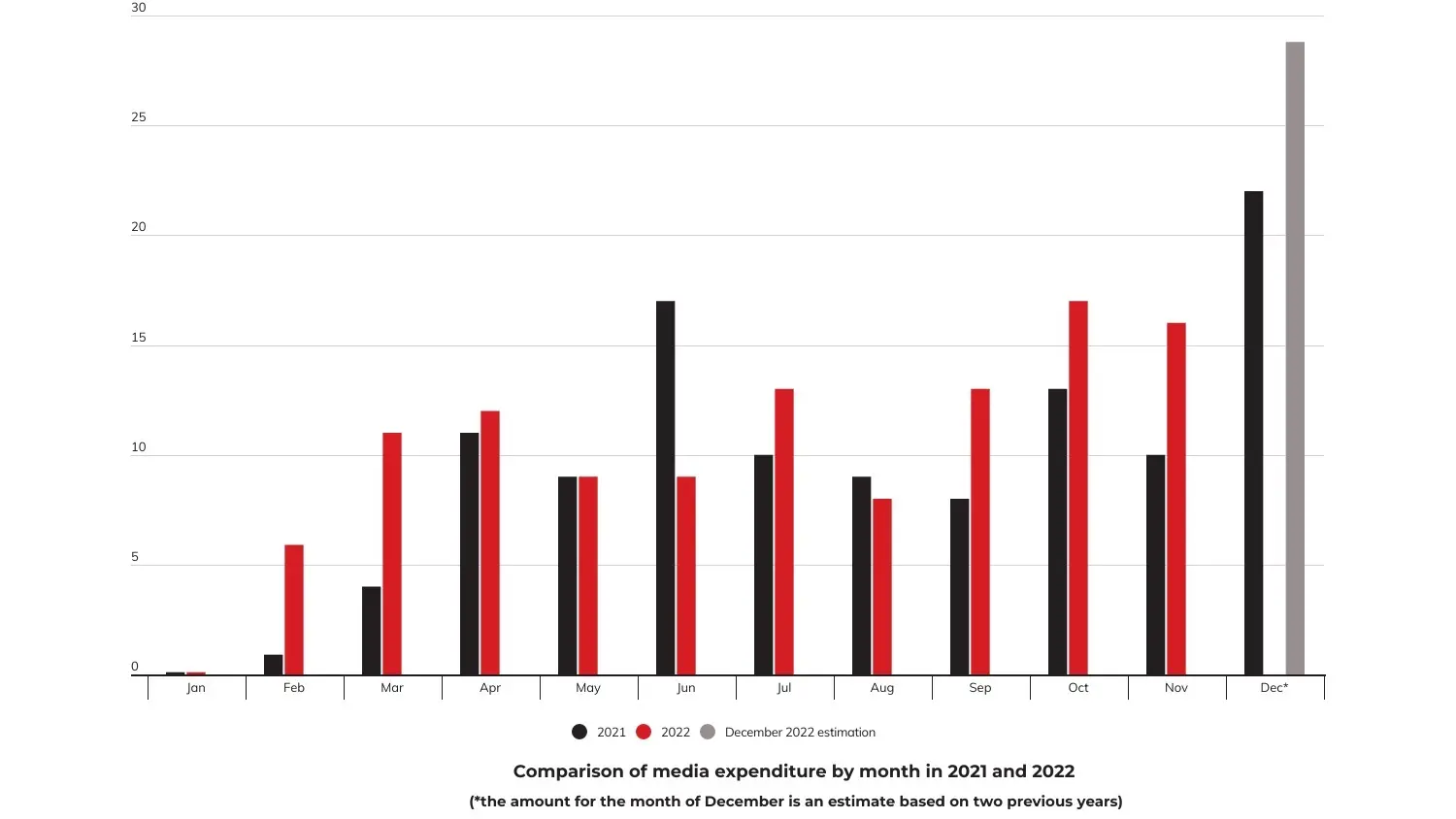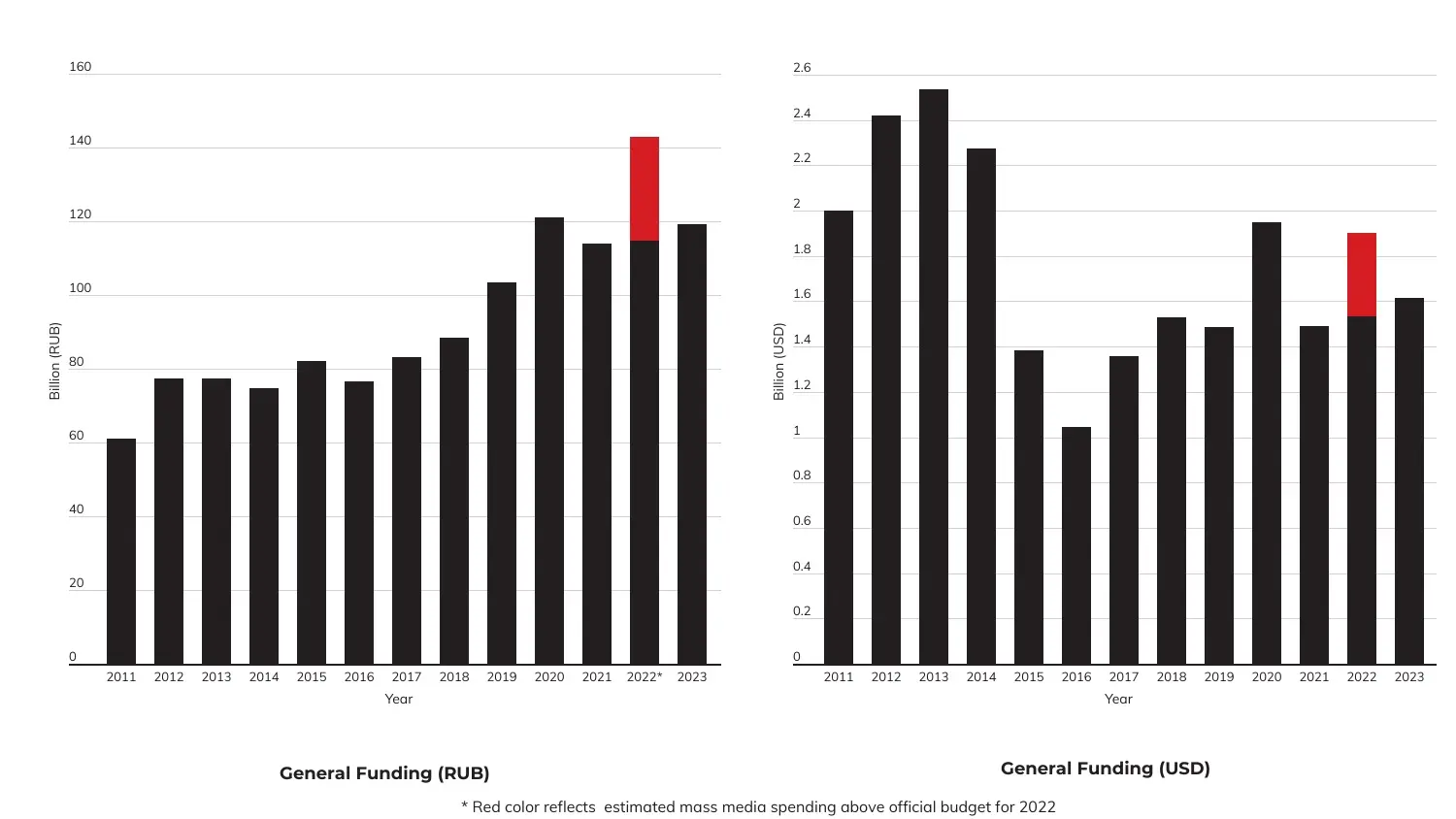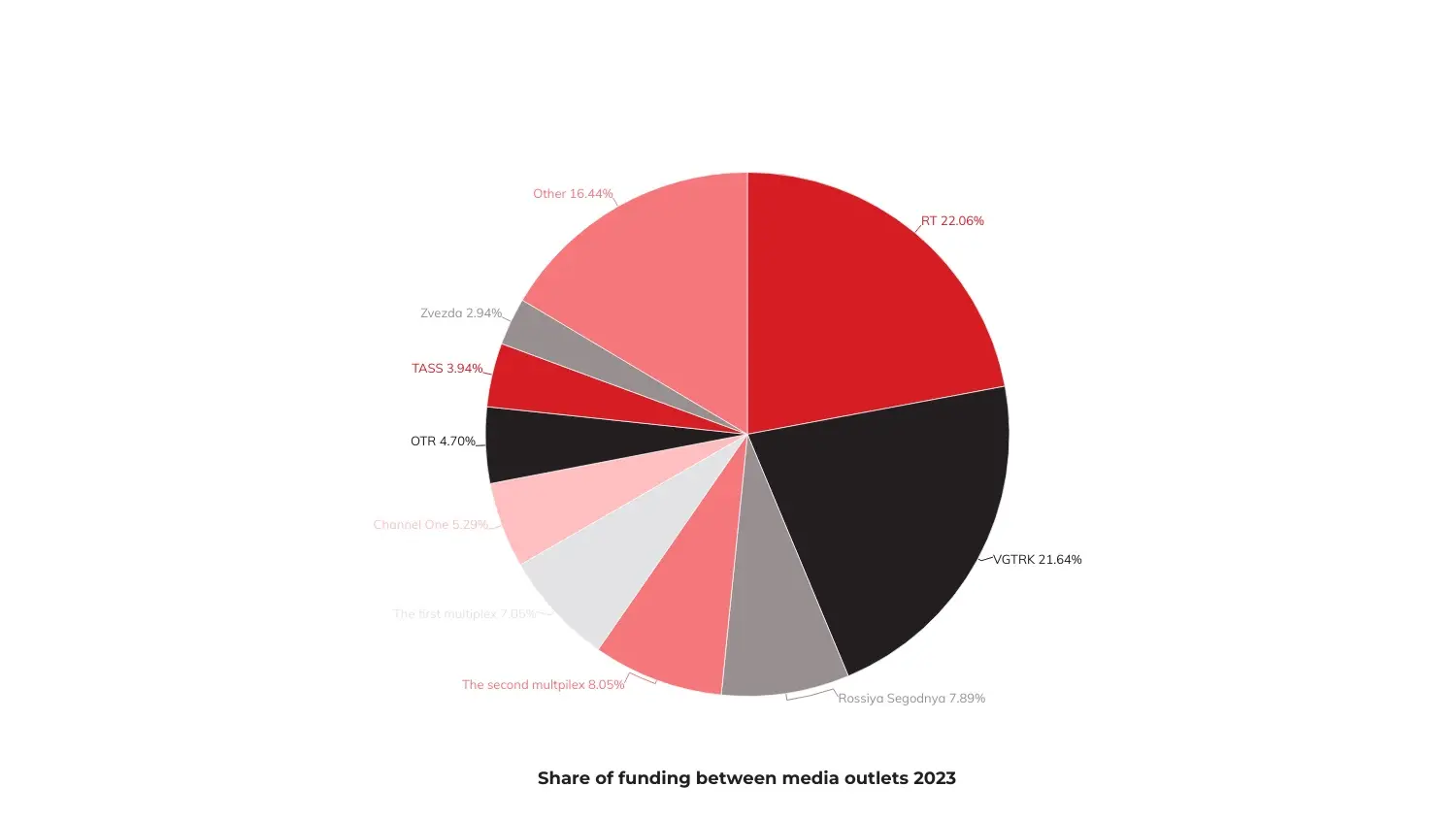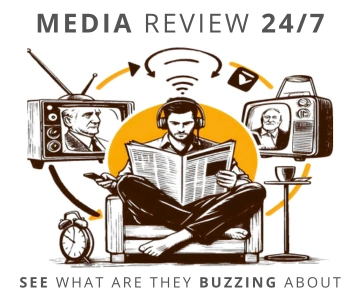 source: Debunk.org
source: Debunk.orgIn 2023, as in previous years, over half of the allocated mass media budget was directed to three key propaganda agencies.
- 51% of the funds went to the All-Russia State Television and Radio Broadcasting Company (VGTRK), RT (formerly Russia Today), and Rossiya Segodnya, notes co-author of the analysis, Aleksandra Michałowska-Kubś.
 source: Debunk.org
source: Debunk.orgVGTRK, a media holding targeting primarily Russian audiences, is set to receive 25.8 billion RUB this year. It operates a network of federal and regional television channels, with programs also available online. However, television popularity in Russia has recently declined - between February and July 2022, the audience for Channel One, Russia-1, and NTV dropped by a quarter. Furthermore, since the war in Ukraine began, VGTRK lost several key foreign sponsors as companies advertising on its channels exited the Russian market. The agency has also been impacted by Western sanctions.
- It seems, however, that 25.8 billion RUB is sufficient to broadcast propaganda domestically and expand media operations in the occupied territories of Ukraine. It was announced that VGTRK is opening branches in the Luhansk, Donetsk, Kherson, and Zaporizhzhia regions, notes Michałowska-Kubś.
Meanwhile, RT, the main pillar of the Kremlin’s international information influence, has seen a slight funding decrease. In 2023, it was allocated 26.3 billion RUB. Sanctions imposed on Russia after the invasion of Ukraine have led the agency to cease broadcasting in the EU, Canada, the US, and the UK and to close selected offices. However, RT has found ways to expand its operations, including entering the Serbian market. RT Balkan plans to start broadcasting no later than 2024. The agency is also strengthening its presence in Asia, Africa, and South America.
Interestingly, another entity funded by the budget has received significant generosity from Russian authorities. In 2023, Zvezda, a media network run by the Russian Ministry of Defense, nearly doubled its funding to 3.5 billion RUB.
 source: Debunk.org
source: Debunk.org- This year`s analysis confirms that propaganda is a key pillar of the regime and one of the Kremlin`s main tools of power. Legal changes threatening up to 15 years in prison for spreading "false information" about the so-called "special military operation" and the elimination of remaining independent media further emphasize that Russian authorities treat information as a weapon - not only against their own citizens. It’s important to remember that for Russia, the information space has always been a battleground, conclude analysts from the think tank Debunk.org.
Debunk.org is an independent tech-focused think tank and NGO specializing in analyzing disinformation and running educational media campaigns across eight countries. It has been countering disinformation since 2017. Link to the full article: https://www.debunk.org/pl/w-zeszłym-roku-propaganda-kosztowała-kreml-1-9-mld-usd-budżet-na-media-został-przekroczony-o-25
SWAMPED and ZASŁONA: Russian Disinformation Techniques
The EU’s East StratCom Task Force, dedicated to identifying disinformation originating outside the EU, published a list on the EUvsDisinfo portal outlining the methods the Kremlin and its agencies use to spread disinformation globally, including in Poland.
The set of disinformation and propaganda techniques is summarized under the acronym SWAMPED:
- S for Straw Man:
Attributing statements or opinions to a person or institution that were never expressed, then mocking, undermining, or attacking those views. - W for Whataboutism:
Creating the illusion of hypocrisy on the opposing side by deflecting accusations with arguments that "you/they did or do something similar." - A for Attack:
Spreading information, often false, aimed at discrediting or compromising the opponent. - M for Mockery:
Ridiculing or mocking the other side, often using out-of-context, exaggerated, or manipulated information. - P for Provocations:
Undermining opinions and beliefs using false but widely distributed claims to sow doubt and distrust. - E for Exhaust:
Distracting from the core issue by overwhelming the opponent with both authentic and fabricated data, statistics, and comparisons. - D for Denial:
A defensive method involving denial of evidence, disclaiming responsibility, and suggesting accusations stem from bias or prejudice.
COMMERCIAL BREAK
New articles in section Media industry
Advertising market 2025. Poland, Europe and the World
Marcin Grządka
The global advertising market is growing by 8.8% in 2025 and will reach a value of 1.14 trillion dollars. The industry result in Europe records slightly lower dynamics, at the level of 5.8%. In this comparison, Poland performs clearly above the average. We will record an increase of 8.9% this year and a value of 18.56 billion PLN - estimates WPP Media in the annual report "This Year Next Year".
The print media market 2025. Three global trends
Krzysztof Fiedorek
The market value is 359.53 billion dollars, yet the erosion is visible to the naked eye. The decline for newspapers will amount to -2.3 percent. Despite this, print retains strength: it generates 76 percent of subscription revenues and enjoys 82 percent consumer trust. The future of the industry is defined by hybrid strategies and niche specialization.
Journalism in the age of AI. Why people prefer humans over machines
Krzysztof Fiedorek
Only 12% of people accept news created solely by AI, while 62% prefer those written by humans. At the same time, only 19% notice labels indicating the use of artificial intelligence, while younger audiences ask AI to explain the content to them. These are the findings of the Reuters Institute report on artificial intelligence in media.
See articles on a similar topic:
Radio Listenership in Poland 2024: Demographics, Trends, and Statistics
Krzysztof Fiedorek
Why do millions of Poles still choose radio? What drives RMF FM's dominance and Eska's surprising results? The latest "Audio Track" report from the National Media Institute reveals listenership data, demographics, and evolving trends. How does the digital revolution affect traditional stations?
Social Media and Relationships. Interesting Research from Palestine
KFi
What does love look like in the digital age? Does technology bring people closer or push them apart? In an era where Facebook and Instagram replace dinner table conversations, social media has become a new space for marital relationships. Researchers from An-Najah National University examined how technology can build bonds but also sow uncertainty.
Future of Public Media. Who Will Be Data Ethicists and VR Designers?
KFi
How does the future of work in media look? Here are professions that do not yet exist but will soon become essential. The report "Future Jobs at PSM: Competencies and Professions for the Media of Tomorrow," prepared by the European Broadcasting Union (EBU) and Rai Ufficio Studi, outlines key changes awaiting the public media sector in the coming years.
Digital media addiction. Why the brain can’t cope
KFi
Digital media can hijack the brain's reward system in ways similar to drugs and alcohol, warned psychiatrist and author Anna Lembke. She emphasized that compulsive use of digital platforms can become a serious addiction. Not just a bad habit or risky behavior.





























